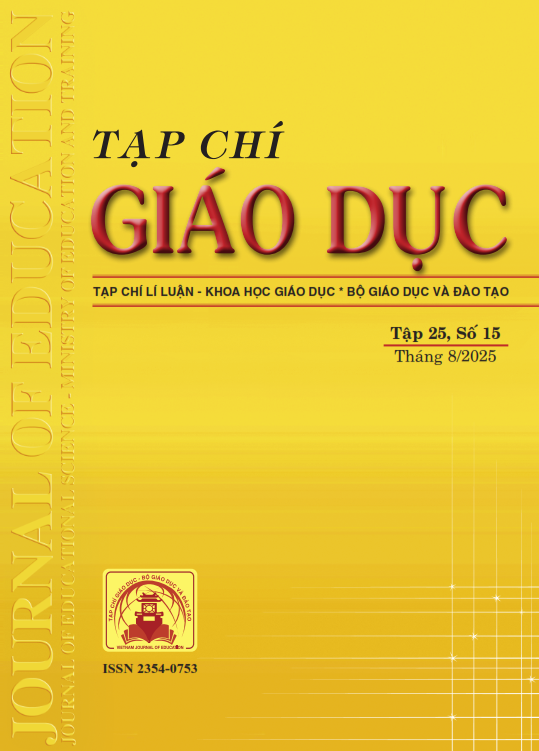Mức độ sẵn sàng học tập tự định hướng của sinh viên trong môi trường Blended Learning: Trường hợp nghiên cứu tại Đại học Bách khoa Hà Nội
Tóm tắt
In the context of digital transformation and higher education reform in Vietnam, Blended Learning has become increasingly popular, especially after the COVID-19 pandemic. Hanoi University of Science and Technology has implemented numerous Blended Learning courses since 2017 through its Learning Management System (LMS). This article evaluates students’ Self-Directed Learning Readiness (SDLR) in a Blended Learning environment, using a quantitative approach with a sample of 360 students from 9 faculties/institutes. The findings indicate that the average SDLR score is 149.56 out of 200 - approaching the high-readiness threshold according to the scale by Fisher et al. (2001). Among the SDLR components, “Desire for Learning” scored the highest (3.92/5), while “Self-Management” the lowest (3.34/5). The students with high GPAs (3.5–4.0) had SDLR scores 18% higher than those with lower GPAs (<2.0). The study recommends integrated solutions to enhance students' self-management abilities, including improved course design, supplementary LMS support tools, and skill development programs, in order to boost learning motivation and improve SDLR among students.
Tài liệu tham khảo
Bouilheres, F., Le, V., McDonald, S., Nkhoma, C., & Jandug-Montera, L. (2020). Defining student learning experience through blended learning. Education and Information Technologies, 25(4), 3049-3069. https://doi.org/10.1007/s10639-020-10100-y
Bùi Ngọc Sơn, Nguyễn Thị Hương Giang, Nguyễn Khang (2022). Đánh giá tác động của chuyển đổi số đến khả năng phát triển mô hình đại học thông minh tại Trường Đại học Bách khoa Hà Nội. Tạp chí Khoa học Giáo dục Việt Nam, 18(5), 58-63.
Dang, T., Tang, T., & Trinh, M. (2021). Review of Self-directed Learning Readiness Assessments Among Undergraduate Students in the World and Lessons Learnt for Vietnam. VNU Journal of Science: Education Research, 37(2), 49-60.
Evenhouse, D., Lee, Y., Berger, E., Rhoads, F., & DeBoer, J. (2023). Engineering student experience and self-direction in implementations of blended learning: a cross-institutional analysis. International Journal of STEM Education, 10(1), 19.
Fisher, M., King, J., & Tague, G. (2001). Development of a self-directed learning readiness scale for nursing education. Nurse Education Today, 21(7), 516-525.
Geng, S., Law, M., & Niu, B. (2019). Investigating self-directed learning and technology readiness in blending learning environment. International Journal of Educational Technology in Higher Education, 16(1), 1-22.
Grow, O. (1991). Teaching learners to be self-directed. Adult Education Quarterly, 41(3), 125-149.
Hsu, C., & Shiue, M. (2005). The effect of self-directed learning readiness on achievement comparing face-to-face and two-way distance learning instruction. International Journal of Instructional Media, 32(2), 143-156.
Huynh, D., Haines, S. T., Plaza, C. M., Sturpe, D. A., Williams, G., Rodriguez de Bittner, M. A., & Roffman, D. S. (2009). The impact of advanced pharmacy practice experiences on students' readiness for self-directed learning. American Journal of Pharmaceutical Education, 73(4), 65. https://doi.org/10.5688/aj730465
Knowles, S. (1975). Self-directed learning: A guide for learners and teachers. Association Press.
Koniah, K., Komariah, A., Mulyati, Y., & Rahmawati, R. (2024). A systematic review of research on blended learning in teaching EFL: Student and teacher's perception, implementation, interaction, benefits, and challenges. Stairs, 5(1), 11-26.
Muhria, L., Usman, M., Baharun, H., Anshori, I., & Mundiri, A. (2023). Students' challenges of blended learning model in higher education. Journal Corner of Education, Linguistics, and Literature, 2(1), 66-78.
Premkumar, K., Vinod, E., Sathishkumar, S., Pulimood, B., Umaefulam, V., Prasanna Samuel, P., & John, T. A. (2018). Self-directed learning readiness of Indian medical students: a mixed method study. BMC Medical Education, 18, 1-10.
Rasheed, A., Kamsin, A., & Abdullah, A. (2020). Challenges in the online component of blended learning: A systematic review. Computers & Education, 144, 103701. https://doi.org/10.1016/j.compedu.2019.103701
Rui, L., Mohamad Nasri, A., & Mahmud, D. (2024). The role of self-directed learning in promoting deep learning processes: a systematic literature review. F1000Research, 13, 761.
Thuy, T., & Thuy, T. (2022). Assessment of self-directed learning readiness among undergraduates of teacher education in Vietnam. In The IAFOR Conference on Educational Research & Innovation 2022 Official Conference Proceedings (pp. 119-130).
Thuy, T., Hung, T., & Lien, P. (2024). Self-directed learning readiness among undergraduate students. Journal of Educational and Social Research, 14(5), 233-249. https://doi.org/10.36941/jesr-2024-0135
Tong, H., Uyen, P., & Ngan, K. (2022). The effectiveness of blended learning on students' academic achievement, self-study skills and learning attitudes: A quasi-experiment study in teaching the conventions for coordinates in the plane. Heliyon, 8(12), e12657.
Tải xuống
Đã Xuất bản
Cách trích dẫn
Số
Chuyên mục
Giấy phép

Tác phẩm này được cấp phép theo Ghi nhận tác giả của Creative Commons Giấy phép quốc tế 4.0 .












